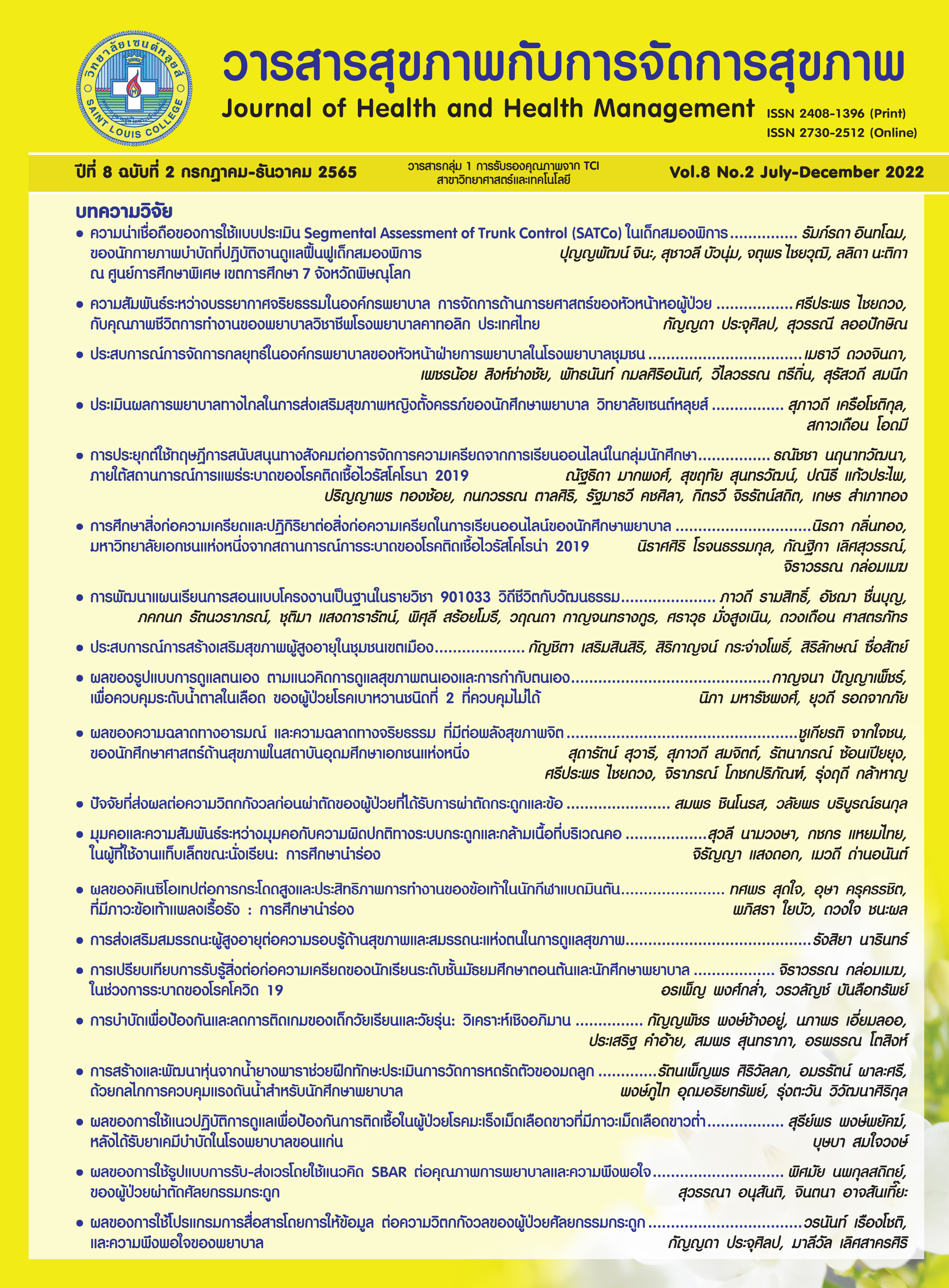Creating and Development of The Rubber Latex Uterine Contraction Practice Model Using Water Pressure Control Mechanism for Nursing Students
Keywords:
practice model, uterine contractionAbstract
The objective of this research and development is to create and develop the rubber latex uterine contraction practice model using a water pressure control mechanism. To compare uterine contraction assessment skills by the rubber latex uterine contraction practice model using a water pressure control mechanism for nursing students before and after the experiment. Moreover, to study their satisfaction with the rubber latex uterine contraction practice model using water pressure. This research consists of 3 phases. The participants include 50 second-year nursing students, from the Faculty of Nursing, Chaiyaphum Rajabhat University. The research instruments are the rubber latex uterine contraction practice model using a water pressure control mechanism, a satisfaction assessment form, and a satisfaction assessment form. The reliability was 0.87. The reliability coefficient of the uterine contraction skill assessment form and the satisfaction assessment form were 0.88 and 0.76. Data were analyzed using content analysis descriptive statistics and t-test (pair t–test). The results revealed that the half-body pregnant woman's model is made of fiberglass covered with rubber, a large abdominal wall, and inside a basin containing a bag to control water pressure. Outwardly appearance resembles a human. This model can be used to measure the uterine contraction assessment. The average scores of the uterine contraction assessment skills after using this model were significantly higher than before the experiment (p-value < 0.05). The overall satisfaction with the uterine contraction measurement skills training with this model for nursing students was at a high level ( =4.33, S.D.=0.58). Therefore, the rubber latex uterine contraction practice model using a water pressure control mechanism can be mimic uterine contractions and suitable for teaching in Maternity Nursing and Midwifery subjects.
References
เกษมศรี ศรีสุพรรณดิฐ. (2564). การคลอดปกติทางช่องคลอด. สืบค้นจาก: https://w1.med.cmu.ac.th/obgyn/lessons/normal-labor/
ขวัญใจ เพทายประกายเพชร และปวีณภัทร นิธิตันติวัฒน์. (2563). นวัตกรรมชุดหุ่นฝึกทักษะการหมุนกลไกการคลอดสำหรับนักศึกษาพยาบาล. วารสารวิจัยสุขภาพและการพยาบาล, 36(3), 233-243.
จิราภรณ์ นันท์ชัย และสมชาย แสงนวล. (2561). การพัฒนาหุ่นจำลองสำหรับฝึกทักษะการประเมินท่าทารกในครรภ์. พยาบาลสาร, 45(4), 37-46.
ปฐมามาศ โชติบัณ, กิตติพร เนาว์สุวรรณ, ธารินี นนทพุทธและจรูญรัตน์ รอดเนียม. (2556). นวัตกรรมชุดหุ่นฝึกทักษะการปฏิบัติการพยาบาล. วารสารมหาวิทยาลัยนราธิวาสราชนครินทร์, 5(3), 1-12.
วิชยา เห็นแก้ว, เทียมศร ทองสวัสดิ์ และไพฑูรย์ ยศกาศ. (2561). การพัฒนาหุ่นต้นแบบ “ดีต่อใจ” เพื่อฝึกการกดหน้าอกสำหรับนักศึกษาพยาบาล.พยาบาลสาร, 45(4), 171-180.
วินัย สยอวรรณ, ศราวุฒิ แพะขุนทด, ปุณณภา ชุมวรฐายี, และเจษฎา อุดมพิทยาสรรพ์. (2561). การพัฒนาหุ่นจำ ลองฝึกทักษะการกดนวดชนิดยางพาราสำหรับนักศึกษาการแพทย์แผนไทยบัณฑิตของวิทยาลัยเทคโนโลยี ทางการแพทย์และสาธารณสุขกาญจนาภิเษก. วารสารการพยาบาลและการศึกษา, 10(3), 71-82.
สุสัณหา ยิ้มแย้ม. (2559).การพัฒนาหุ่นจำลองเพื่อฝึกทักษะทางคลินิกของนักศึกษาสาขาวิทยาศาสตร์สุขภาพ. พยาบาลสาร, 43(2), 142-151.
สุสัณหา ยิ้มแย้ม และโสภา กรรณสูต. (2556). การพัฒนาหุ่นจำลองเต้านม FON CMU เพื่อการสอนการเลี้ยงบุตรด้วยนมมารดา. พยาบาลสาร, 40(4), 56-68.
สุสัณหา หา ยิ้มแย้ม, นันทพร แสนศิริพันธ์, และนงลักษณ์ เฉลิมสุข.(2561). การพัฒนากล่องจำลองการตรวจภายในเพื่อฝึกประเมินความก้าวหน้าของการคลอด. พยาบาลสาร, 45(3), 83-96.
สำนักอนามัยการเจริญพันธุ์กรมอนามัย กระทรวงสาธารณสุข. (2560). แผนปฏิบัติการภายใต้นโยบายและยุทธศาสตร์การพัฒนาอนามัยการเจริญพันธุ์แห่งชาติ ฉบับที่ 2 (พ.ศ. 2560 - 2569) ว่าด้วยการส่งเสริมการเกิดและการเจริญเติบโตอย่างมีคุณภาพพ.ศ.2560-2562. กรุงเทพฯ: ชุมนุมสหกรณ์การเกษตรแห่งประเทศไทย จำกัด
อภินันท์ สุประเสริฐ. (2558). นิทรรศการงานวิจัย”บูรณาการงานวิจัย รังสรรค์สิ่งใหม่เพื่อสังคม” หุ่นจำลองยางพารา สื่อประหยัดเพื่อการศึกษาไทย. สืบค้นจาก http://www3.rdi.ku.ac.th/exhibition/47_1/04/04.htm
Allahem,H., Sampalli,s. (2022). Automated labour detection framework to monitor pregnant women with a high risk of premature labour using machine learning and deep learning. Informatics in Medicine Unlocked ,28,1-12. https://doi.org/10.1016/j.imu.2021.100771
Chooha, U., Chotwattanakulchai, N., & Sirisome, J. (2022). Development and application of “Cervical Dilatation Model for Teaching and Training”. Advances in Medical Education and Practice, 13, 1123–1131.
Hungsawanus, P., Pasiphol ,S.& Kanjanawasee , S. (2021). The quality of a model of nursing practice competency assessment in the labor room by applying an assessment center. Kasetsart Journal of Social Sciences, 42, 645–652. Retrieved from: DOI:10.2147/AMEP.S374832
Yochum, M., Laforêt, J., & Marque, C. (2016). An electro-mechanical multiscale model of uterine pregnancy contraction. Computers in biology and medicine, 77, 182-194.
Downloads
Published
How to Cite
Issue
Section
License
Copyright (c) 2022 Journal of health and health management

This work is licensed under a Creative Commons Attribution-NonCommercial-NoDerivatives 4.0 International License.




